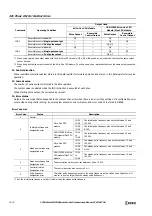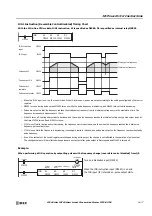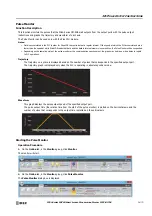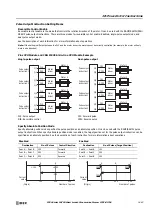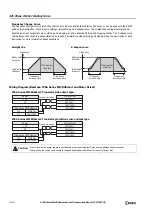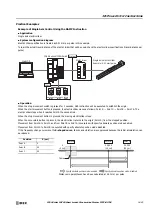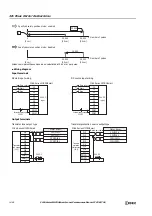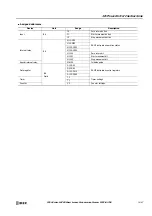
18: P
ULSE
O
UTPUT
I
NSTRUCTIONS
18-72
FC6A S
ERIES
MICROS
MART
L
ADDER
P
ROGRAMMING
M
ANUAL
FC9Y-B1726
JOG (JOG Operation)
The JOG instruction output pulses with a frequency change.
Operation
When the input is on and the JOG input specified by S3 is turned on, pulses of the initial pulse frequency specified by S1 are
output, and then the pulse frequency is increased at a constant rate until it reaches the steady pulse frequency. When the steady
pulse frequency is reached, steady pulses are output.
When the JOG input specified by S3 is turned off, the pulses slow at a constant rate until the initial pulse frequency is reached, and
when the initial pulse frequency is reached, pulse output stops.
The pulse control information (output on/output complete/error) is stored in the internal relays specified by D1 as the operation
status.
When the initialization input specified by S2 is turned on, the initial values configured in the WindLDR
JOG (JOG Control)
dialog
box, on the
Settings
tab, are stored in the control registers.
Notes:
•
If a pulse output instruction is simultaneously executed with the same output, a user program execution error will occur.
Error code 48 will be stored in D8006 and instructions that are executed later will be canceled.
•
The JOG instruction cannot be used in an interrupt program. If used in an interrupt program, a user program execution error will occur. Error
code 18 will be stored in D8006 and instruction execution will be canceled.
•
If a pulse output instruction is executed with the relay output type, a user program execution error will occur.
Error code 19 will be stored in D8006 and instruction execution will be canceled.
•
For user program execution errors, see "User Program Execution Errors" on page 3-10.
Valid Devices
Special data registers cannot be designated as S1. Special internal relays cannot be designated as D1.
D1
*****
S3
*****
JOG
1
S2
*****
S1
*****
JOG
2
JOG
3
JOG
4
D1
*****
S3
*****
S2
*****
S1
*****
D1
*****
S3
*****
S2
*****
S1
*****
D1
*****
S3
*****
S2
*****
S1
*****
Device
Function
I
Q
M
R
T
C
D
P
Constant
Repeat
S1 (Source 1)
Control register
—
—
—
—
—
—
—
—
—
S2 (Source 2)
Initialization input
X
—
X
—
—
—
—
—
—
—
S3 (Source 3)
JOG input
X
—
X
—
—
—
—
—
—
—
D1 (Destination 1)
Status code
—
—
—
—
—
—
—
—
—
Summary of Contents for MICROSmart FC6A Series
Page 1: ...B 1726 7 FC6A SERIES Ladder Programming Manual ...
Page 8: ...Preface 7 FC6A SERIES MICROSMART LADDER PROGRAMMING MANUAL FC9Y B1726 ...
Page 32: ...1 OPERATION BASICS 1 20 FC6A SERIES MICROSMART LADDER PROGRAMMING MANUAL FC9Y B1726 ...
Page 96: ...3 INSTRUCTIONS REFERENCE 3 18 FC6A SERIES MICROSMART LADDER PROGRAMMING MANUAL FC9Y B1726 ...
Page 130: ...4 BASIC INSTRUCTIONS 4 34 FC6A SERIES MICROSMART LADDER PROGRAMMING MANUAL FC9Y B1726 ...
Page 192: ...9 SHIFT ROTATE INSTRUCTIONS 9 12 FC6A SERIES MICROSMART LADDER PROGRAMMING MANUAL FC9Y B1726 ...
Page 272: ...12 DISPLAY INSTRUCTIONS 12 24 FC6A SERIES MICROSMART LADDER PROGRAMMING MANUAL FC9Y B1726 ...
Page 284: ...14 REFRESH INSTRUCTIONS 14 6 FC6A SERIES MICROSMART LADDER PROGRAMMING MANUAL FC9Y B1726 ...
Page 502: ...25 DATA LOG INSTRUCTIONS 25 22 FC6A SERIES MICROSMART LADDER PROGRAMMING MANUAL FC9Y B1726 ...
Page 546: ...26 SCRIPT 26 44 FC6A SERIES MICROSMART LADDER PROGRAMMING MANUAL FC9Y B1726 ...
Page 598: ...APPENDIX A 14 FC6A SERIES MICROSMART LADDER PROGRAMMING MANUAL FC9Y B1726 ...



















